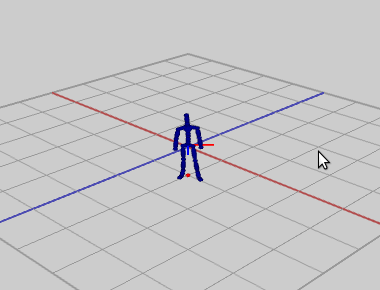Assignment 11: Steering and crowds
In which, we implement a steering algorithm and crowd behaviors
Due Thursday, Dec 9, before midnight
The goal of this lab is to
-
Implement a physics-based steering model for our character
-
Implement a variety of boid behaviors
Get the source
On Github, do a Fetch Upstream to synchronize your forked repository with the class repository.
Then update the source on your local machine and rebuild.
> git pull
> cd build
> cmake ..; makeUser interface overview
The camera can be controlled with the mouse:
-
Left-button drag with the mouse to rotate
-
Right-button drag with the mouse to pan
-
Middle-button drag with the mouse to zoom
-
space button will reset the view and demo
Control-left click will set the position of the target (red dot)
Code overview
The code for this assignment includes the class ASteerable, which implements a
steerable character, and the class ABehavior, which implements various steering behaviors.
Subclasses of ABehavior compute desired velocities which are 'fed' to the steering
algorithm in ASteerable. You can control how a character moves by changing its behavior.
1. Steering
In the files, behaviors-basecode.cpp and steerable-basecode.cpp, implement the steering model from class.
To run from the build directory, do the following
> ../bin/a11-steeringWe will build up our steering model in steps.
Step 1: Implement a simple seek behavior with basic steering model
Implement ASeek::computeDesiredVelocity.
This method should return a desired velocity (with speed MaxSpeed) which points toward the given target.
You should also set default values for "MaxSpeed" and "AgentRadius" in ABehavior’s constructor. You may need to tweak this parameter to produce nice looking results with your steering algorithm.
Step 2: Implement the steering algorithm
Compute _vd and _thetad in ASteerable::senseControlAct.
Given a desired velocity and dt, senseControlAct computes a global translation and rotation
and stores them in the member variable atk::Transform _characterRoot.
Note: above that although in class, the vehicle has X forward (and rotates around Z), note that in your basecode Z is forward (and we rotate around Y).
Your application should look like this

Importantly, to get nice movement, we need to tweak the gains:
-
ASteerable::kVelKp, -
ASteerable::kOriKp, and -
ASteerable::kOriKv.
One approach is to tweak these values manually. First, make large changes to find a good magnitude for your parameter. Then make smaller changes to fine-tune. Also, change parameters systematically, one at a time.
However, our orientation controller is an example of proportional derivative control, which has well-understood properties. Specifically, recall that our dynamics equation is
We first solve for \(\tau\). Then we compute a new angular acceleration with \(\ddot{\theta} = \tau/I\). The angular acceleration is then used to turn our vehicle. The constants \(k_P, k_V\) for this type of controller can be defined in terms of two parameters \(w_n\) and \(\zeta\) like so
\(w_n\) is called the natural frequency and stem[\zeta] is called the damping ratio. The rate of convergence follows the function \(e^{-\zeta w_n t}\), so this function will be close to zero when \(\zeta w_n t = 4\). We can use this to choose \(\zeta\) and \(w_n\) so that we converge at an approximate time.
Furthermore, the choice \(\zeta\) will determine if the system is underdamped (e.g. oscillates), critically-damped (smoothly goes to \(\theta_d\)), or over-damped. Specifically,
-
Underdamped \(0 \leq \zeta < 1\). In the example below, we have \(w_n = 8, \zeta = 0.25\). This choice of values results in \(k_V = 4, k_P = 64\)

-
Critically damped \(\zeta = 1\). In the example below, we have \(w_n = 8, \zeta = 1\). This choice of values results in \(k_V = 16, k_P = 64\)

-
Overdamped \(\zeta > 1\). In the example below, we \(w_n = 8, \zeta = 2\). This choice of values results in \(k_V = 32, k_P = 64\)

Step3: Compute values for the gains kOriKp and kOriKv such that the character’s turning is critically damped and converges in approximately 0.5 seconds.
Tip: You may find that if the character sits a while, it accumulates movement. You can fix this by either adding a special case to not update when the character is close to the goal, or by implementing a more sophisticated behavior which returns a desired velocity of zero when within a threshold of the goal.
2. Behaviors
In behaviors-basecode.cpp, implement four additional behaviors of your choice.
To run from the build directory, do the following
> ../bin/a11-behaviorsOption 1 Implement individual behaviors such as flee, avoid obstacles, arrive, depart, and wander. Or even create your own! Be sure to document any new behaviors you create in your readme.
Option 2 Implement a crowd. Extend the basecode to create N characters and implement alignment, cohesion, separation, leader.
3. Unique
Personalize the behaviors demo from this assignment. Here are some ideas:
-
Make your crowd look heterogeneous (in
Steerable::randomizeAppearance) by-
randomizing the colors
-
randomizing the sizes
-
randomizing the animation time so that motions are no longer synchronized
-
-
Improve the animation of the characters. Implement a walk controller which blends between walking and standing based on the character’s speed. When the speed is zero, the character should idle. When it is walking at the max speed, it should be walking.
-
Animate crowds with different types of characters, such as butterflies or stampeding elephants.
-
Implement crowds with different-sized characters, such as large ogres mixed with small goblins.
4. Hand-in your work
4.1. What to hand-in
-
Your code
-
Images, movies, gifs, as appropriate
-
Your readme
4.2. How to hand-in
Check-in your code, images, and writeup and push the changes to Github. If everything is uploaded correctly, you will see your work on Github.
> cd animation-toolkit
> git add <files>
> git commit -m "helpful message"
> git pushBest practice is to always commit changes as you work, rather than waiting until the end to commit changes. You can always revert to an old version if you need to!
Your code should download and compile without modifications. Test your assignment on a lab machine (Park 230) to ensure that it works.
4.3. Generating images, movies and gifs
Screenshots
On Ubuntu, you can take a screenshot by
-
Prt Scrn to take a screenshot of the desktop.
-
Alt + Prt Scrn to take a screenshot of a window.
Gifs
On Ubuntu, you can use Peek to create gifs.
Movies
On Ubuntu, you can use recordmydesktop to record movies in .ogv format.
By default, the whole desktop is recorded unless you give it a window id.
To get the window id, call xwininfo and click on the window. Then pass the
id to recordmydesktop.
> recordmydesktop --windowid <WindowId> --no-sound --v_quality 30 -o <name>.ogvTo check the video, open it in firefox.
> firefox <name>.ogv| Files larger than 100 MB cannot be checked into git. In general, videos should be less than 5 MB. |
4.4. Update your Readme.md
Update assignments/a11-motion/Readme.md to document the features in your assignment. Your readme should contain your images, gifs, and movies.
On github, you can drag and drop movies into your readme files. Images and gifs can also be added that way, or by including text such as the following
This Guide can help you with writing markdown.